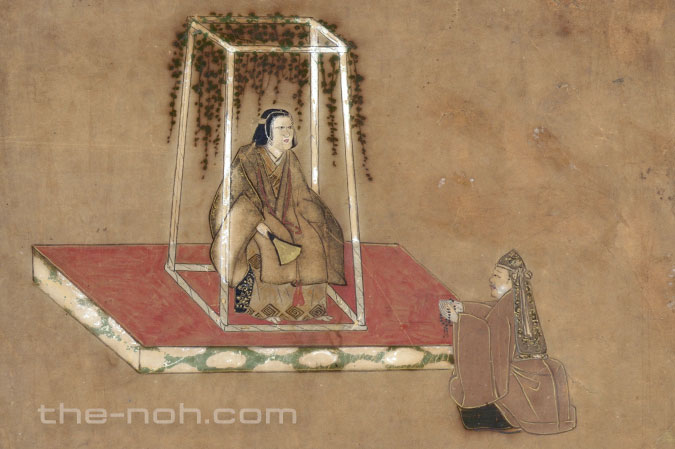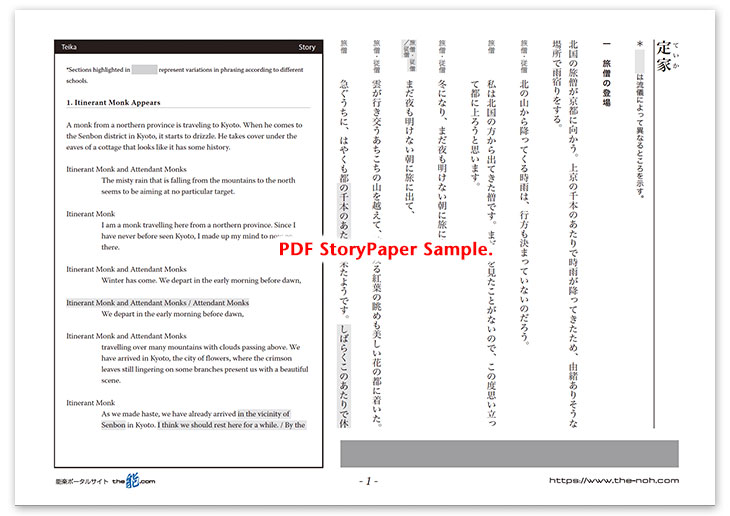
 Teika
Teika

![]()
One day in early winter, an itinerant monk travelling from a northern province arrives at Senbon in Kyoto. He is enjoying the beautiful scenery in the evening when it suddenly starts drizzling, so he takes cover under the eaves of a cottage that looks like it has some history. Then, a local woman appears before the monk. She tells him that this cottage, the Pavilion of Misty Rain, was built by Fujiwara no Teika (1162 - 1241) and encourages the monk to conduct a memorial service for Teika’s soul. The woman takes him to the grave of Princess Shikishi and recounts the story of Teika, who consummated his deep desire for Princess Shikishi and whose attachment to her was so strong that, even after both of them had died, it took the form of teika-kazura (Asiatic jasmine) whose vines are still entwined around the princess’s grave. She goes on to ask the monk to free the couple who are suffering from this obsessive attachment. She then disappears after revealing that she is the ghost of Princess Shikishi.
Talking with a local man, the itinerant monk hears the story of the secret love affair of Teika and Princess Shikishi that led to Asiatic jasmine being named after Teika. The local man encourages the monk to stay longer and perform a memorial service to console the souls of the couple. When the monk is reciting scripture from the Lotus Sutra, the ghost of Princess Shikishi appears from her grave. She is pleased because she has been freed from the clinging jasmine vines that have fallen away. In order to repay her debt of gratitude to the monk, she performs a dance. However, feeling ashamed of her unsightly appearance, the ghost returns to her grave, which is entangled by the vines of the teika-kazura.
![]()
Although the title of this play is “Teika,” Fujiwara no Teika himself does not appear in it. Instead, Princess Shikishi — a poet with several poems included in Shin-Kokin-wakashū (New Collection of Poems Ancient and Modern) and other poetry anthologies — narrates her love affair with Teika. Both Teika and Princess Shikishi are well-known poets and their poems are cited in this drama quite effectively. (However, historical records are silent about any relationship between them or whether they were actually lovers)
Set at the center of the stage is the prop of a grave entangled by the teika-kazura (Asiatic jasmine) vines that represent Teika’s obsessive desire. As shite (the lead character) disappears into her grave shortly before the intermission starts, she seems to have burnt the outline of her figure onto the gravestone, leaving a profound impression upon the audience. The dance performed by Princess Shikishi in the second half of the play depicts, with reserved dignity, her suffering. The mask worn by the lead character in the second half varies depending on the school and stage directions, which may create different impressions in different productions of this play.
Considered to be one of the master works of Noh, this play overlays and contrasts Teika’s obsessive desire for Princess Shikishi with her own conflicted, complicated emotions and therefore, it must be performed with great sensitivity.
STORY PAPER : Teika
Story Paper presents noh chant stories in modern speech, with story outlines, highlights and more using Adobe PDF format, which can print out and zoom in. Print out the pages and take them with you when you see the actual noh performance.

The copyright of Story Paper is held by the Noh.com. Story Paper is for individual use only. It is prohibited by the copyright law to distribute or publish printed-out Story Paper pages without prior consent. For more information, check the credit and disclaimer pages.



 [Teika : Story Paper PDF : 546KB
[Teika : Story Paper PDF : 546KB